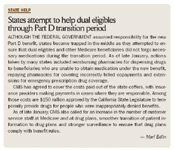Beneficiaries getting caught between a rock and a copay
If misery loves company, then Beverly Thomas of Carbondale, Ill.,isn't alone. She is one of thousands of dual eligibles(beneficiaries covered by both Medicaid and Medicare) who went tothe pharmacy after January 1, 2006, only to find that it would notfill their prescriptions. Unfortunately, her medication for mentalillness is so critical that if she misses even a day, she could behospitalized. With the help of Southern Illinois Regional SocialServices, Thomas got squared away, but admits she still is confusedabout how the new Medicare Part D benefit operates.

Everybody has a story. New York Senator Hillary Rodham Clinton related the problems of one of her constituents, a cerebral palsy patient who had been filling his critical prescriptions at the same pharmacy for years. After Part D kicked in, the drug cost him $42 because of a glitch in the system. The family pharmacist fronted the drug cost, hoping to get reimbursed.
As many as 73% of dual eligibles have an annual income below $10,000, compared with 12% for all other Medicare beneficiaries, and have twice the rate of poor health; they represent about half of current Medicaid spending, according to the Kaiser Commission on Medicaid and the Uninsured. This large group-more than 6 million-has been automatically enrolled in new Medicare Part D plans without responsibility for premiums or deductibles.
Dual eligibles, who represent about one-seventh of the 42 million total Medicare beneficiaries eligible for Part D, also are facing: copayments for the first time; little opportunity to acquire necessary drugs if they are unable to afford the copayment; no access to an emergency supply of drugs while eligibility is being checked or prior authorization approved; and no coverage for certain drugs.
Random assignment to a Prescription Drug Plan (PDP) in a beneficiary's geographic region (whose premium is at or below the benchmark for the region) often results in duals landing in a plan that does not include all of their current drugs on its formulary or does not network with their pharmacy of choice.
Although duals have the opportunity to change PDPs monthly, unlike other Medicare beneficiaries, many healthcare professionals agree that the population of duals-the poorest, sickest, least-educated and costliest to treat-will be less inclined to make a change, either because they don't understand the options or do not know how to disenroll from a plan. In addition, it may be impossible to find a plan that covers a dual eligible's needs and still falls at or below the benchmark premium amount.
Tom Paul, chief pharmacy officer for Ovations, a business unit of UnitedHealth Group that addresses the needs of members 50 years and older, strongly advocates that dual eligibles complete the process for changing plans early in the previous month so that they will be enrolled by the following month.
Despite contingency plans by the Centers for Medicare & Medicaid Services (CMS), such as a point-of-sale enrollment mechanism allowing dual eligibles who were not enrolled in Part D before its start to present evidence of Medicare and Medicaid eligibility to receive their prescriptions, the transition period in January did not proceed smoothly. The Kaiser Commission on Medicaid and the Uninsured notes that if there is an error of only 0.5%, a large number of dual eligibles will face a gap in coverage.
Last November, the Kaiser Commission, in conjunction with Health Management Associates, conducted a focus group of 12 Medicaid officials whose concerns validated what would transpire in January:
David Calabrese of OptumRx Talks New Role, Market Insulin Prices and Other Topics 'On His Mind'
April 13th 2023In this month’s episode of the "What's On Your Mind podcast," Peter Wehrwein, managing editor of MHE connects with the now Chief Clinical Officer of OptumRx Integrated Pharmacies, David Calabrese. In this conversation, David touches on his transition in January as OptumRx’s former chief pharmacy officer and market president of health plans and PBMs to his new role as Chief Clinical Officer where he now focuses more on things such as specialty pharmacy to home delivery — with an overall goal of creating whole-patient care. Throughout the conversation, Calabrese also touched on the market’s hot topic of insulin prices and behavioral health services within the OptumRx community, among other topics.
Listen
A Conversation With Greg Baker, RPh, CEO of AffirmedRx
March 31st 2024Greg Baker, CEO of AffirmedRx, describes his early career, shares some of his critical opinions about the pharmacy benefit management (PBM) industry and how, in his view, his company is offering a better alternative.
Read More
Briana Contreras, editor of Managed Healthcare Executive, spoke with Nancy Lurker, CEO and president of EyePoint Pharmaceuticals. Nancy shared a bit about EyePoint and how the organization’s innovative therapies are addressing patient needs through eye care, and most importantly, she addressed C-Suite positions like the CEO role. Nancy shared advice for those seeking to reach the CEO level, especially toward women in healthcare and other roles, and what it takes to run a biopharma company.
Listen
Florida Gets the OK. But Will Drug Importation from Canada Actually Happen?
March 5th 2024Canadian health officials warn that maintaining a drug supply for Canadians is their priority. The staunch opposition of the U.S. pharmaceutical industry may also be an obstacle to imports from north of the border.
Read More
The deliberate disconnection of Change Healthcare to ring fence a cyberattack entered its seventh day today. Prescribers are finding ways to get pharmacy claims processed, and UnitedHealth Group says disruption to the dispensing of prescriptions has been minimal. But independent pharmacies want more information and protection from financial consequences from pharmacy benefit managers.
Read More